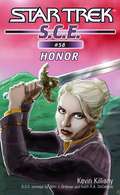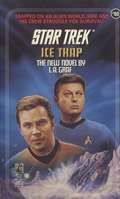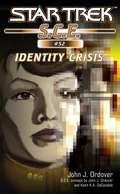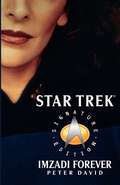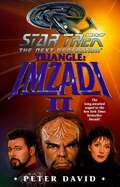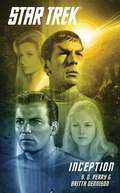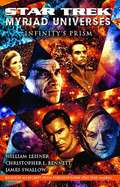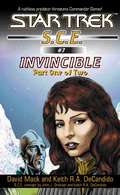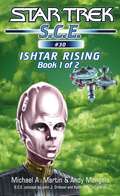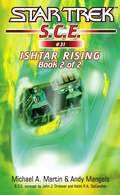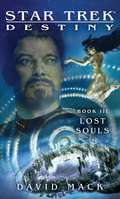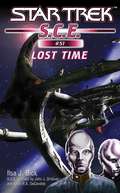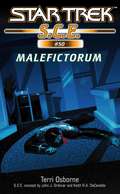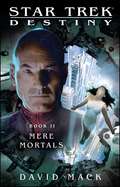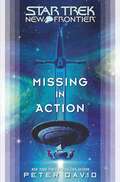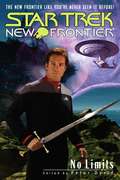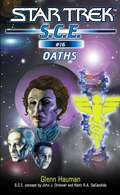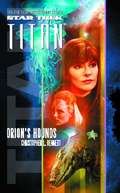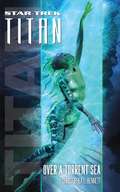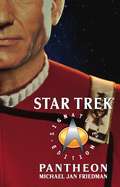- Table View
- List View
Star Trek: Honor (Star Trek: Starfleet Corps of Engineers #58)
by Kevin Killiany#58 STARFLEET CORPS OF ENGINEERS While repairing an observation post, P8 Blue and Domenica Corsi find themselves caught in the middle of an interplanetary conflict involving a pre-warp civilization -- with one side unwilling to fight, even to defend themselves. Unable to stand idly by and allow a slaughter to take place, Corsi and Blue must risk breaking the Prime Directive in a fight that they may not even win.... HONOR
Star Trek: Ice Trap
by L. A. GrafSent to the icebound planet of Nordstral to investigate a mysterious outbreak of insanity, the crew of the U.S.S. Enterprise find themselves drawn into another, even deadlier mystery upon their arrival. A team of research scientists has disappeared on Nordstral's frozen wasteland, leaving no clue to their whereabouts, and no hint of their fate. WHile Uhura and Chekov tackle the mystery surrounding the scientists' disappearance, Kirk and McCoy search for the truth behind the outbreak of mental illness. But both teams soon find themselves in danger, as the planet undergoes a series of massive earthquakes and electromagnetic disruptions. Unable to contact he U.S.S. Enterprise, both teams must fight for their lives as they try to solve the mystery of Nordstral -- before the world tears itself apart!
Star Trek: Identity Crisis
by John J. OrdoverSTARFLEET CORPS OF ENGINEERS The da Vinci is returning to Hidalgo Station,a run-down old spacedock that has seen better decades, in order to pick up Commander Sonya Gomez from a much-needed shore leave. But when they arrive they find that Gomez has taken the station hostage, and is making insane demands -- if they aren't met, she'll blow up the station. No one is more surprised than Gomez herself, who is trapped inside Hidalgo's control center with no way out -- and no way to stop her shipmates from thinking she's gone mad. Alone, the S.C.E.'s leader must find a way out of her trap before her shipmates take drastic action! IDENTITY CRISIS
Star Trek: Imzadi Forever (Star Trek: The Next Generation)
by Peter DavidImzadi: to the people of the planet Betazed, including Counselor Deanna Troi of the Starship Enterprise, it means "beloved" and denotes that which can never be truly broken. Yet to whom does Deanna's heart truly belong? Commander William Riker was the first Deanna called Imzadi. Long before they served together on board the Enterprise, they shared a tempestuous love affair back on Betazed. And even now, many years later, Riker will embark on a desperate journey across time and space to save Deanna's life. But Riker is not the only Starfleet officer to capture Deanna's heart. Lieutenant Commander Worf, the fierce Klingon warrior, is also drawn to Deanna's gentle and caring nature. Brought together by fate, he and Deanna share an unexpected passion that tests the bonds between Troi and Riker -- even as a deadly Romulan conspiracy threatens them all! Bonus: An Exclusive Interview with the Author This edition includes Imzadi and Imzadi II: Triangle.
Star Trek: Imzadi II (Star Trek: The Next Generation)
by Peter DavidEven in the 24th century, three is definitely a crowd. Imzadi: to the people of the planet Betazed, including Counselor Deanna Troi of the Starship Enterprise , it means "beloved" and denotes a special closeness that can never be truly broken. Or can it? In his acclaimed earlier novel, Imzadi, bestselling author Peter David explored the special bond between Deanna Troi and Commander William T. Riker. It revealed new facets of their long and intimate relationship and put that bond to its ultimate test in a powerful and unforgettable story that remains one of the most popular Star Trek® adventures ever published. Imzadi was a New York Times bestseller in both hardcover and paperback. Now David examines the heart of Deanna Troi from an altogether different perspective, as he reveals for the first time the full story of Troi's troubled romance with Lieutenant Commander Worf. At first glance, they cannot be more different. She is an empath, gentle and acutely sensitive to the needs and feelings of others. He is a fierce Klingon warrior, dedicated to a harsh and warlike code of honor. Brought together, however, by a common need to care for Alexander, Worf's troubled, motherless son, they discover hidden reserves of courage and compassion within each other. Soon mutual respect leads to much stronger emotions as they embark on an unexpected courtship, much to the surprise and discomfort of William Riker. But does Worf's future truly lie with Deanna...or on a distant outpost called Deep Space 9 ? And whom indeed shall Troi ultimately call "imzadi"? Imzadi II is a compelling story, an untold chapter in the history of the Starship Enterprise .
Star Trek: Inception (Star Trek: The Original Series)
by S.D. PerryAs man expands beyond explored space, the need to find a way to make inhospitable planets habitable grows greater. One young biologist, Carol Marcus, has a project that she believes can reshape planets. A young committed scientist, she dares to dream of a Federation where there is never any hunger and every world is a paradise. Her dream is shared by James Kirk, a young Starfleet officer and her lover. One of Carol’s more enthusiastic team members is botanist Leila Kalomi. Leila finds Carol’s passion contagious, and sparks the interest of the Enterprise’s science officer, Spock, who convinces her to join Project: Inception.
Star Trek: Infinity's Prism (Star Trek)
by Christopher L. Bennett James Swallow William LeisnerA collection of alternate reality tales from the Star Trek universe.In &“A Less Perfect Union,&” more than a hundred years after the Terra Prime movement achieved its dream of an isolationist Earth, humanity is once again at a fork in the river of history...and the path it follows may ultimately be determined by the voice of a single individual: the sole surviving crewmember of the first U.S.S.Enterprise. Then follows &“Places of Exile.&” Midway through Voyager&’s journey across the galaxy, Captain Kathryn Janeway and Commander Chakotay must choose whether to brave a deadly war zone or abandon their quest for home. But an attack by Species 8472 cripples the ship, and the stranded crew must make new choices that will reshape their destinies...and that of the Delta Quadrant itself. Finally, Khan is victorious in &“Seeds of Dissent.&” Almost four centuries after conquering their world, genetically enhanced humans dominate a ruthless interstellar empire. But the warship Defiance, under its augmented commander, Julian Bashir, makes a discovery that could shake the pillars of his proud civilization: an ancient sleeper ship from Earth named the Botany Bay.
Star Trek: Invincible Book One (Star Trek: Starfleet Corps of Engineers #7)
by David Mack Keith R. DeCandidoSTARFLEET CORPS OF ENGINEERS One of the S.C.E.'s top officers, Commander Sonya Gomez, is assigned to supervise a project on the crystal planet of Sarindar -- helping the reclusive and hostile Nalori harness a valuable new ore. Morale is low and the project is behind schedule. Gomez must get the workers up to speed and on track -- a task made more difficult by the Nalori workers, who do not want her there even though their government does. Just when Gomez begins to gain their trust, two workers are killed by a mysterious local animal called a shii. Gomez must learn the secret of the shii before it kills again.... The first in a gripping, all-new two-part adventure!
Star Trek: Ishtar Rising Book 1
by Andy Mangels Michael A. MartinProject Ishtar -- a bold endeavor to terraform Venus, the most volatile planet in the solar system, and the grandest achievement in the spectacular career of famed terraformer Dr. Pascal Saadya. But when Saadya hits a snag in the project, he calls upon his old friend, Captain David Gold of the U.S.S. da Vinci. Part of Saadya's team is a Bynar pair, 1011 and 1110, who are using their species' natural affinity for computers to increase efficiency. Saadya's hope is that they can join forces with the da Vinci's Bynar pair. But half of the Bynar pair assigned to the S.C.E. team on the da Vinci was killed months ago, leaving only Soloman -- a non-bonded Bynar who is now a pariah in their culture. Saadya finds himself confronted not only with a failing project, but with Bynar prejudice, as 1011 and 1110 treat Soloman with nothing but contempt....
Star Trek: Ishtar Rising Book 2
by Andy Mangels Michael A. MartinProject Ishtar -- the bold endeavor to terraform Venus, the most volatile planet in the solar system -- has reached a critical juncture. The project's first phase has had unexpected consequences that could tear Venus apart -- and mean the deaths of dozens of project workers and the S.C.E.'s computer expert, the un-bonded Bynar now called Soloman. Now, with time running out, Soloman must move past the prejudice of his fellow Bynars -- who view his "single" status with disdain -- and find a solution before disaster strikes!
Star Trek: Lost Souls (Star Trek: The Next Generation)
by David MackThe third and final novel in an epic crossover trilogy uniting characters from every corner of the Star Trek universe, revealing the shocking origin and final fate of the Federation's most dangerous enemy—the Borg.The soldiers of Armageddon are on the march, laying waste to worlds in their passage. An audacious plan could stop them forever, but it carries risks that one starship captain is unwilling to take. For Captain Jean-Luc Picard, defending the future has never been so important, or so personal—and the wrong choice will cost him everything for which he has struggled and suffered. For Captain William Riker, that choice has already been made. Haunted by the memories of those he was forced to leave behind, he must jeopardize all that he has left in a desperate bid to save the Federation. For Captain Ezri Dax, whose impetuous youth is balanced by the wisdom of many lifetimes, the choice is a simple one: there is no going back—only forward to whatever future awaits them. But for those who, millennia ago, had no choice...this is the hour of their final, inescapable destiny.
Star Trek: Lost Time
by Ilsa J. BickSTARFLEET CORPS OF ENGINEERS Almost a year after the S.C.E. crew on the da Vinci helped Lieutenant Nog of Deep Space 9 salvage the hulk of DS9's sister station Empok Nor, a booby trap left behind by the Androssi threatens the Bajoran system. But the potential damage may be greater than the combined crews of the da Vinci and DS9 can handle, as the threat stretches across two universes -- and their only hope for survival may rest with their long-dead crewmates 111 and Kieran Duffy! LOST TIME
Star Trek: Maker (Cold Equations #6)
by Michael Jan FriedmanDiscover Captain Jean Luc Picard's first command aboard the Stargazer in this Star Trek: The Next Generation novel.Ensign Andreas Nikolas, heartsick over the loss of his Mirror Universe lover, has resigned his post on Jean-Luc Picard's starship, the Stargazer, to seek a home on the freighter Iktoj'ni. All he wants of his new life is a chance to forget his troubles. And that's what he gets—until the Iktoj'ni is taken over by a monstrous alien with unbelievable powers and a disdain for all forms of life. Without saying why, the alien sends the freighter hurtling toward a part of space inhabited by the Ubarrak, the Federation's deadliest and most xenophobic enemy. And Nikolas, who fears that the incident will start a war, can't convince his captor to turn back. Picard's only hope of stopping the alien menance is Serenity Santana—a woman who once abused his trust in the name of her people's survival. Now she's back, asking for the captain's trust a second time. Picard desperately needs Santana's help in his struggle to save his galaxy. But will she justify his faith in her—or once again twist it to serve her own shadowy ends?
Star Trek: Malefictorum
by Terri OsborneWithout warning, a member of the da Vinci crew is found dead in his quarters. Lt. Commander Corsi's investigation is thorough and complete -- and turns up nothing. With all the technology at Starfleet's disposal, with all the technical expertise of the ship's crack team of S.C.E. engineers, no forensic evidence can be found to explain the fatality. With the possibility of an unknown murderer on board, Corsi must use all her training to solve the mystery -- before another body falls...
Star Trek: Mere Mortals (Cold Equations)
by David MackOn Earth, Federation President Nanietta Bacco gathers allies and adversaries to form a desperate last line of defense against an impending Borg invasion. In deep space, Captain Jean-Luc Picard and Captain Ezri Dax join together to cut off the Collective's route to the Alpha Quadrant. Half a galaxy away, Captain William Riker and the crew of the Starship Titan have made contact with the reclusive Caeliar -- survivors of a stellar cataclysm that, two hundred years ago, drove fissures through the structure of space and time, creating a loop of inevitability and consigning another captain and crew to a purgatory from which they could never escape. Now the supremely advanced Caeliar will brook no further intrusion upon their isolation, or against the sanctity of their Great Work....For the small, finite lives of mere mortals carry little weight in the calculations of gods. But even gods may come to understand that they underestimate humans at their peril.
Star Trek: Mind Meld (Star Trek: The Original Series #82)
by John VornholtTeska, a Vulcan child raised on Earth, is destined to play a crucial role in the reunification of the Vulcan and Romulan peoples. While Spock escorts his young niece back to Vulcan for her betrothal ceremony, he strives to help her understand both her Vulcan heritage and her growing telepathic abilities. But when an unplanned mind meld reveals the true identity of a deadly assassin to Teska, she and Spock find themselves the target of a Rigelian criminal network. With the EnterpriseTM light-years away, Spock and his niece must go on the run, pursued by a conspiracy determined to end teska's future before it has even begun.
Star Trek: Mirror Universe: Shards and Shadows (Star Trek)
by Marco Palmieri Margaret ClarkFractured history. Broken lives. Splintered souls. Since the alternate universe was first glimpsed in the classic episode "Mirror, Mirror," something about Star Trek's dark side has beckoned us, called to us, tempted us -- like forbidden fruit on the Tree of Knowledge. To taste it is to lose oneself in a world of startling familiarity and terrifying contradictions, where everything and everyone we knew is somehow disturbingly different, and where shocking secrets await their revelation. What began in 2007 with Glass Empires and Obsidian Alliances -- the first truly in-depth foray into the turbulent history of this other continuum -- now continues in twelve new short tales that revisit and expand upon that so-called "Mirror Universe," spanning all five of the core incarnations of Star Trek, as well as their literary offshoots, across more than two hundred years of divergent history, as chronicled by... Christopher L. Bennett - Margaret Wander Bonanno - Peter David - Keith R.A. DeCandido - Michael Jan Friedman - Jim Johnson - Rudy Josephs - David Mack - Dave Stern - James Swallow - Dayton Ward & Kevin Dilmore - Susan Wright
Star Trek: Missing in Action (Star Trek: The Next Generation)
by Peter DavidIn this Star Trek: New Frontier novel, the crew of the USS Excalibur find themselves thrust into another universe—and must find a way home by any means possible.Following the dramatic events of After the Fall, Captain Mackenzie Calhoun and the crew of the USS Excalibur find themselves catapulted headlong into another universe, far from the New Thallonian Protectorate and Sector 221-G...a place where an ancient war rages between two powerful alien races. But Calhoun has no intention of staying here for very long and, adopting the time-honored philosophy of &“the enemy of my enemy is my friend,&” takes it upon himself to somehow (and by any means necessary) persuade one side or the other to help him and his crew get back home. Meanwhile, the shadow of war has fallen over the New Thallonian Protectorate, and an embattled Si Cwan faces growing treachery as he attempts to maintain his tenuous hold on power. With Starfleet and the Federation declaring Sector 221-G temporarily off-limits, Admiral Elizabeth Shelby and Captain Kat Mueller decide to take matters into their own hands, ignoring orders by trying to find some way of getting to the Excalibur, presuming there is any Excalibur to get to. But they never count on the most unexpected of allies—an old friend whose shifting loyalties are about to be put to the ultimate test even as a growing cataclysm looms...
Star Trek: No Limits Anthology
by Peter DavidIn 1997, Star Trek: New Frontier® debuted and became an instant sensation, chronicling the exciting adventures of Captain Mackenzie Calhoun and the U.S.S. Excalibur, as told by New York Times bestselling author Peter David. Now, over a dozen books later, Peter David has gathered some of the finest Star Trek authors to tell new tales of the Excalibur crew: Dayton Ward's thrilling adventure from Calhoun's sordid past Loren L. Coleman's tale of Shelby's first experience with the Borg Robert Greenberger's origin of "Lefler's Laws" Susan Shwartz's adventure with Soleta and Ambassador Spock Terri Osborne's chronicle of Selar's encounter with the Q David Mack's tale of the longest day of Zak Kebron's life plus stories by Keith R.A. DeCandido, Susan Wright, Josepha Sherman, Ilsa J. Bick, Kevin Dilmore, Christina F. York, Robert T. Jeschonek, Peg Robinson, Mary Scott-Wiecek, Allyn Gibson, and Glenn Hauman & Lisa Sullivan. Added Bonus! Peter David himself tells the untold story of Calhoun and Shelby's honeymoon on Xenex!
Star Trek: Oaths
by Glenn HaumanStarfeet Corps of Engineers Dr. Elizabeth Lense has had a fine career. She was first in her class at Starfleet Medical - ahead of the genetically enhanced Julian Bashir -- and a hero during the Dominion War, and is now the chief medical officer on the U.S.S. da Vinci. but Captain David Gold notices that her performance has not been up to snuff. She's been listless and stressed, and is delegating most of her responsibilities to the da Vinci's Emergency Medical Hologram. Her malaise couldn't possibly come at a worse time, because a virus has erupted on Sherman's Planet -- and the planet's entire population, as well as the crew of the da Vinci, are now marked for death by the virulent plague! Can Lense find her way out of depression to determine a cure? And will the cure the worse than the disease?
Star Trek: Obsidian Alliances (Star Trek)
by Peter David Sarah Shaw Keith R. DeCandidoSome say the line between good and evil is narrower than we imagine -- a divide as subtle as a mirror, and perhaps just as deep. To peer into its black, reflective glass is to know the dark potential we each possess, and we cross that obsidian boundary at our peril . . . into a world where we no longer recognize who we are or what we believed ourselves capable of. In the late twenty-fourth century, decades after the fall of the once-mighty Terran Empire, the Klingon-Cardassian Alliance dominates the worlds that, in another reality, made up the United Federation of Planets. Humanity and its former subject races are now bound together by their shared oppression, slaves to their cruel and brutal conquerors. But a downtrodden few have found the courage and the strength of will to act. Inspired by visitors from another continuum to fight for their freedom, they have rekindled hope . . . and rediscovered an ancient truth: that every revolution begins with a vision. Star Trek: VOYAGER ® A rebel ship commanded by a former slave named Chakotay attempts to evade pursuit in the Badlands . . . only to encounter a strange ship that was catapulted seventy thousand light-years across the galaxy. On board the craft are two aliens, one of whom has the potential to completely alter the balance of power within the Alliance. But as both sides of the struggle race to get to the stranger first, treachery throws all schemes into a tailspin. Star Trek: NEW FRONTIER ® Following the Terran Empire's collapse, its longtime rival, the Romulan Star Empire, has absorbed many of the fringe civilizations spread across that part of the galaxy. One of the Romulans' slaves is M'k'nzy of Calhoun, a savage and unpredictable Xenexian who dreams of death . . . and who learns the value of freedom from the unlikeliest of teachers, a Romulan named Soleta. Star Trek: DEEP SPACE NINE ® One fallen dictator's struggle to regain her power and her position leads to the discovery of a bold rebel plan for a decisive military strike against the Alliance. But while Kira Nerys navigates the dangerous road of politics, sex, and military intrigue that she believes will lead her back to reclaiming the Intendancy, cracks form in the rebel leadership, leading to a showdown that will change the course of the Mirror Universe.
Star Trek: Old Wounds
by Christie GoldenThe eagerly awaited continuation of HOMECOMING and THE FARTHER SHORE! Captain Chakotay is ready to prove himself as the new commanding officer of the Starship Voyager -- but skeptics back at Starfleet Command are watching him closely for any sign that he will revert to his renegade Maquis ways. His first mission as captain, to transport a group of displaced colonists back to their home planet of Loran II, seems easy enough: make sure the planet is safe for colonization, unload the settlers, and head back to Earth. He even has an extra reason to enjoy the trip -- his sister, Sekaya, has joined the mission as a spiritual advisor to the gentle, peace-loving colonists. But when the crew arrives at Loran II, they discover a mysterious storm, an ominously deserted settlement -- and a hidden threat from Chakotay's past that could destroy them all. Will Chakotay's first mission as captain of Voyager also be his last?
Star Trek: Orion's Hounds (Star Trek: The Next Generation)
by Christopher L. BennettAs the U. S. S. Titan ventures beyond the outermost reaches of known space, the telepaths in her crew—including Diplomatic Officer Donna Troi—are overwhelmed by an alien cry of distress, leading the ship to the scene of a shocking act of carnage: a civilazation of insterstellar &“whalers&” preying upon and exploiting a familiar species of sentient spacebource giants. Appalled but reluctant to rush to judgement, Captain William Riker and his crew in investigate, discovering a cosmic spawning ground in a region of active star formation—the exosystem for a bewildering array of diverse but similarly vast life-forms. While attempting to negotiate an end to the victimizeation of these creatures, Riker&’s crew inadvertently grants them the means to defeat their hunters&’ purpose…only to learn that things are not exactly as they seem.
Star Trek: Over a Torrent Sea (Star Trek: The Next Generation)
by Christopher L. BennettAs the Federation recovers from the devastating events of Star Trek: Destiny, Captain William Riker and the crew of the U.S.S. Titan are ordered to resume their deep-space assignment, reaffirming Starfleet's core principles of peaceful exploration. But even far from home on a mission of hope, the scars of the recent cataclysm remain with them as they slowly rebuild their lives. The planet Droplet is a world made mostly of water without a speck of solid ground. Life should not exist here, yet it thrives. Aili Lavena, Titan's aquatic navigator, spearheads the exploration of this mysterious world, facing the dangers of the vast, wild ocean. When one native species proves to be sentient, Lavena finds herself immersed in a delicate contact situation, and Riker is called away from Deanna Troi at a critical moment in their marriage. But when good intentions bring calamity, Lavena and Riker are cut off from the crew and feared lost. Troi must face a life-changing event without her husband, while the crew must brave the crushing pressures of the deep to undo the global chaos they have triggered. Stranded with her injured captain, Lavena must win the trust of the beings who control their fate -- but the price for Riker's survival may be the loss of everything he holds dear.
Star Trek: Pantheon (Star Trek: The Original Series)
by Michael Jan FriedmanFrom Earth to the edge of our galaxy and beyond, from the early days of warp flight to the latter half of the twenty-fourth century, humankind and its alien partners in the Federation have looked to their heroes to expand the limits of their knowledge. And as each generation's pantheon of heroes has passed on into legend, a new generation has risen to take its place. So it was with the crew of the S.S. Valiant, the first Earth vessel to cross the galactic barrier. So it was with the crew of the Starship Stargazer and her fledgling commander, Captain Jean-Luc Picard. And so it was with the U.S.S. Enterprise NCC-1701-D, the flagship of Starfleet, which Picard commanded with wisdom and temperate maturity. Over the years, Fate has woven the voyages of these three vessels into a vivid skein of treachery and sacrifice, hardship and determination, tragedy and courage -- each step of the way demonstrating the immeasurable worth of the flawed but farseeing heroes who commanded them. This eBook includes the novels, VALIANT and STARGAZER ONE.
